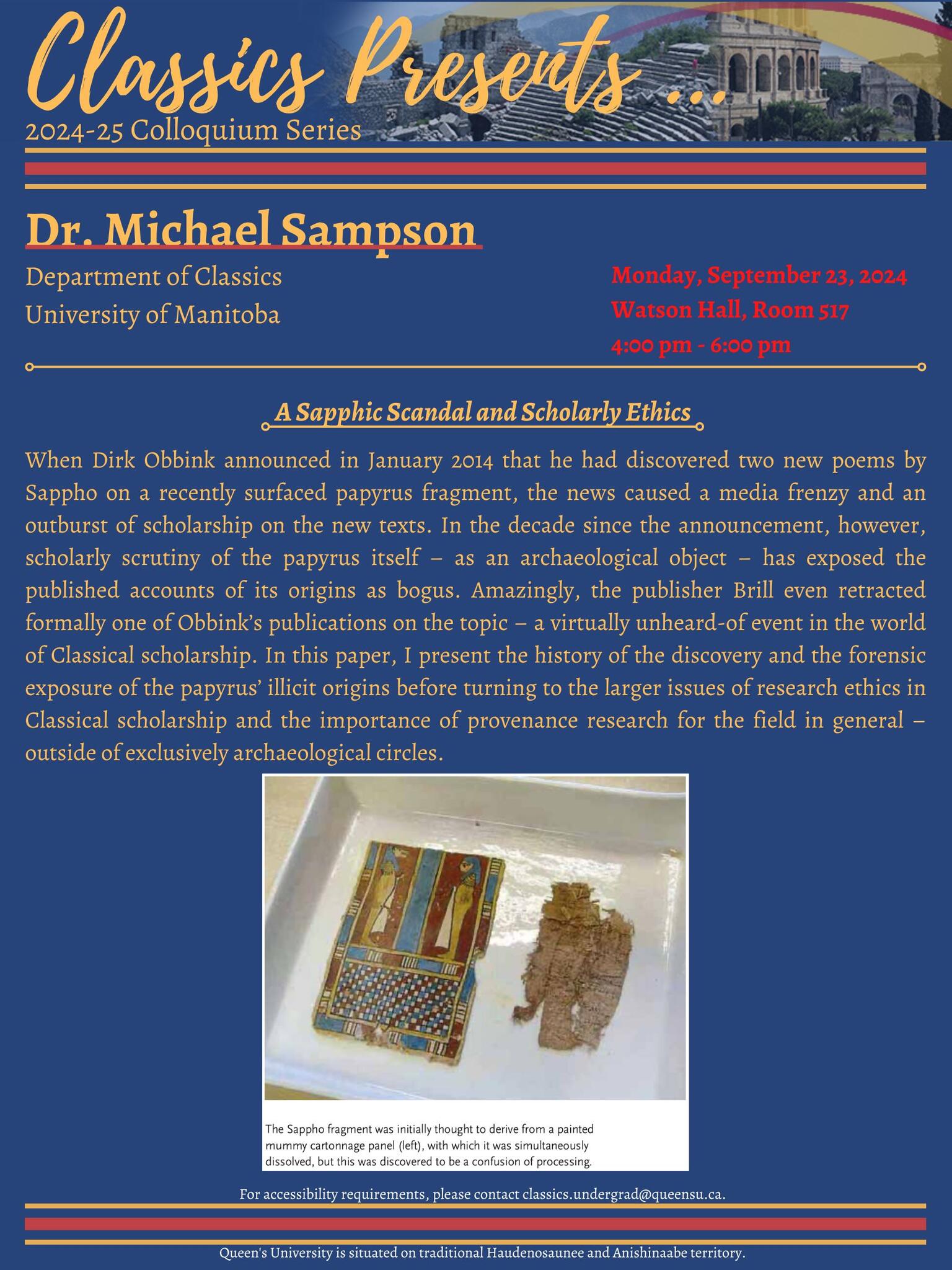Fall 2025
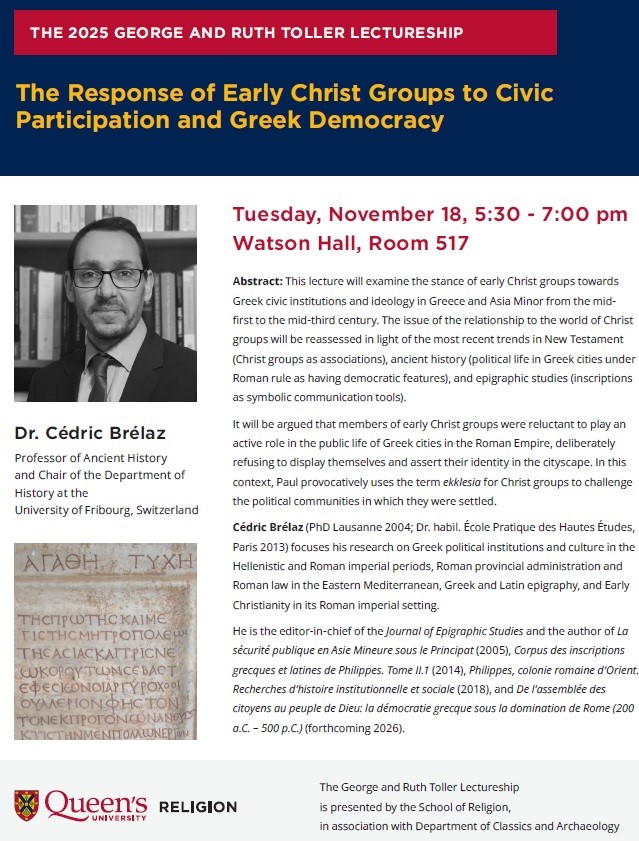
Dr. Cédric Brélaz
Tuesday, November 18, 2025, from 5:30 - 7:00 pm in Watson Hall - Room 517
The Response of Early Christ Groups to Civic Participation and Greek Democracy
This lecture will examine the stance of early Christ groups towards Greek civic institutions and ideology in Greece and Asia Minor from the mid-first to the mid-third century. The issue of the relationship to the world of Christ groups will be reassessed in light of the most recent trends in New Testament (Christ groups as associations), ancient history (political life in Greek cities under Roman rule as having democratic features), and epigraphic studies (inscriptions as symbolic communication tools).
It will be argued that members of early Christ groups were reluctant to play an active role in the public life of Greek cities in the Roman Empire, deliberately refusing to display themselves and assert their identity in the cityscape. In this context, Paul provocatively uses the term ekklesia for Christ groups to challenge the political communities in which they were settled.
Cédric Brélaz (PhD Lausanne 2004; Dr. habil. École Pratique des Hautes Études, Paris 2013) focuses his research on Greek political institutions and culture in the Hellenistic and Roman imperial periods, Roman provincial administration and Roman law in the Eastern Mediterranean, Greek and Latin epigraphy, and Early Christianity in its Roman imperial setting.
He is the editor-in-chief of the Journal of Epigraphic Studies and the author of La sécurité publique en Asie Mineure sous le Principat (2005), Corpus des inscriptions grecques et latines de Philippes. Tome II.1 (2014), Philippes, colonie romaine d’Orient. Recherches d’histoire institutionnelle et sociale (2018), and De l’assemblée des citoyens au peuple de Dieu: la démocratie grecque sous la domination de Rome (200 a.C. – 500 p.C.) (forthcoming 2026).

Dr. Emily Varto
Thursday, November 13th, 2025, at 5:30 pm in Watson Hall 217
Hungry like the wolf or the pig? Early Greek Imagery of Animal Hunger
What does the imagery of animal hunger in early Greek poetry and art reveal about the pursuit of human wants and needs? This talk will expose cultural ideas about heroism, gender, and power suggested by scenes of animal hunting and feeding.
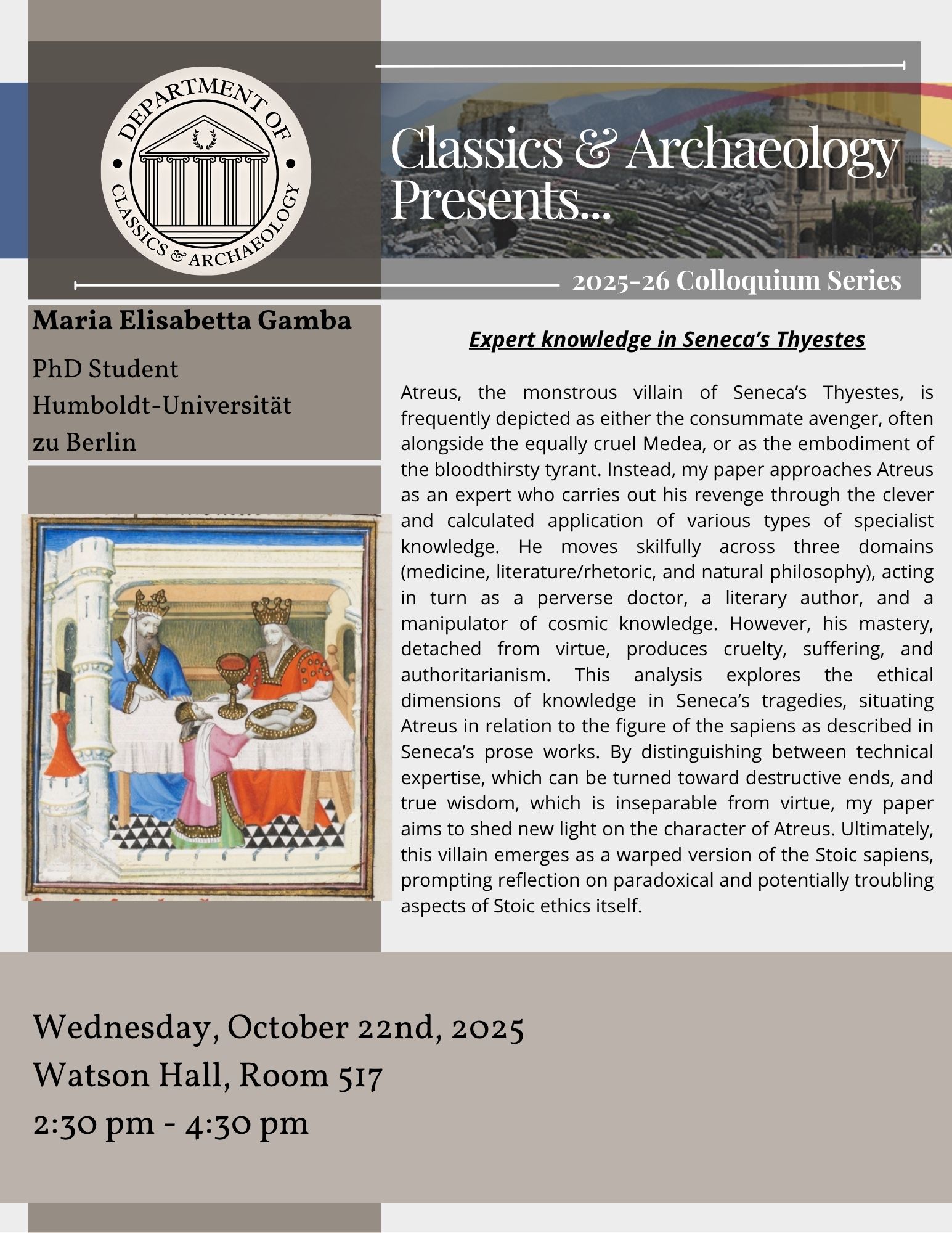
Maria Elisabetta Gamba
Wednesday, October 22, 2025, from 2:30 - 4:30 pm in Watson Hall Room 517
Expert knowledge in Seneca’s Thyestes
Atreus, the monstrous villain of Seneca’s Thyestes, is frequently depicted as either the consummate avenger, often alongside the equally cruel Medea, or as the embodiment of the bloodthirsty tyrant. Instead, my paper approaches Atreus as an expert who carries out his revenge through the clever and calculated application of various types of specialist knowledge. He moves skilfully across three domains (medicine, literature/rhetoric, and natural philosophy), acting in turn as a perverse doctor, a literary author, and a manipulator of cosmic knowledge. However, his mastery, detached from virtue, produces cruelty, suffering, and authoritarianism. This analysis explores the ethical dimensions of knowledge in Seneca’s tragedies, situating Atreus in relation to the figure of the sapiens as described in Seneca’s prose works. By distinguishing between technical expertise, which can be turned toward destructive ends, and true wisdom, which is inseparable from virtue, my paper aims to shed new light on the character of Atreus. Ultimately, this villain emerges as a warped version of the Stoic sapiens, prompting reflection on paradoxical and potentially troubling aspects of Stoic ethics itself.

Dr. Shane Hawkins
Wednesday, September 17th, 2025, from 2:30PM - 4:30PM in Watson Hall Room 517.
Voices from the Grave: New Papyri of Euripides’ Ino and Polyidus
In September of 2024, scholars published what is being called one of the most significant discoveries relating to ancient Greek tragedy in nearly 60 years. Two years earlier, archaeologists working at the necropolis of Philadelphia, Egypt, discovered a small cache of papyrus in the shallow grave of a woman. The papyrus records nearly 100 lines from two lost plays by the great tragedian Euripides. Ino is a tale of Dionysian frenzy and the gruesome murder of innocent children, while Polyidus raises questions about the extent of human power and free will as it portrays the struggle of the titular seer against the tyrannical demands of King Minos to resurrect his dead son.
Shane Hawkins teaches ancient Greek language and literature at Carleton University, where he is an Associate Professor and Director of the College of the Humanities. He has published on Homer, Greek lyric and iambic poetry, and comparative linguistics. He is preparing a book on Greek Iambic Poetry and, with colleagues, an Outline of the Historical and Comparative Grammar of Ancient Greek.
Winter 2025

Dr. Joshua Paul
Wednesday, March 26th, 2025, from 2:30 PM - 4:00 PM in Watson Hall Room 517.
The Road to Brundisium: Parodies of Epicureanism in Horace’s Satires
I argue that Horace Satire 1.5 (the so-called “Journey to Brundisium”) presents a candid day in the life of a cartoonishly exaggerated Epicurean. The narrator constantly succumbs to the various pitfalls and stereotypes associated with the Garden. I draw attention to the narrator’s eager memorization of doctrine, self-centered conceptions of friendship, constant miasma of sickliness, and obsession with food. I then demonstrate how this philosophical caricature explains the protagonist’s complete apathy towards the political embassy, defangs the biting vitriol of potential detractors, and facilitates in-group bonding among fellow Epicureans within the Circle of Maecenas.

Dr. Cristiana Zaccagnino
Wednesday, March 19th, 2025, from 2:30 PM - 4:30 PM in Watson Hall Room 517.
Not Only Divination. Birds in Etruria: A Few Case Studies
Among Etruscans, birds certainly played an important religious role. Augurs interpreted the will of the gods observing their flight, songs, and feeding behaviours. According to Pliny the Elder (NH 10.17.37), moreover, several bird species were also treated in Etruscan books on auspicia, but according to the Latin author, no one at his time had ever seen them. This affirmation seems to confirm that Etruscans were used to detailed descriptions of birds, but also that some bird species had probably already disappeared before Pliny’s time.
In Etruscan art, the depictions of birds frequently show a high level of observation and attention to specific details which allow a precise identification and a better understanding of the settings in which they appear.
Even though the religious and symbolic aspect of birds in Etruria will not be overlooked, special attention will be given to species which were not native to the Italian peninsula and their reception, such as the rooster, and migratory birds, such as the swallow. Along with artistic representations and ancient literary sources, archaeozoological data, when available, will be taken into consideration.
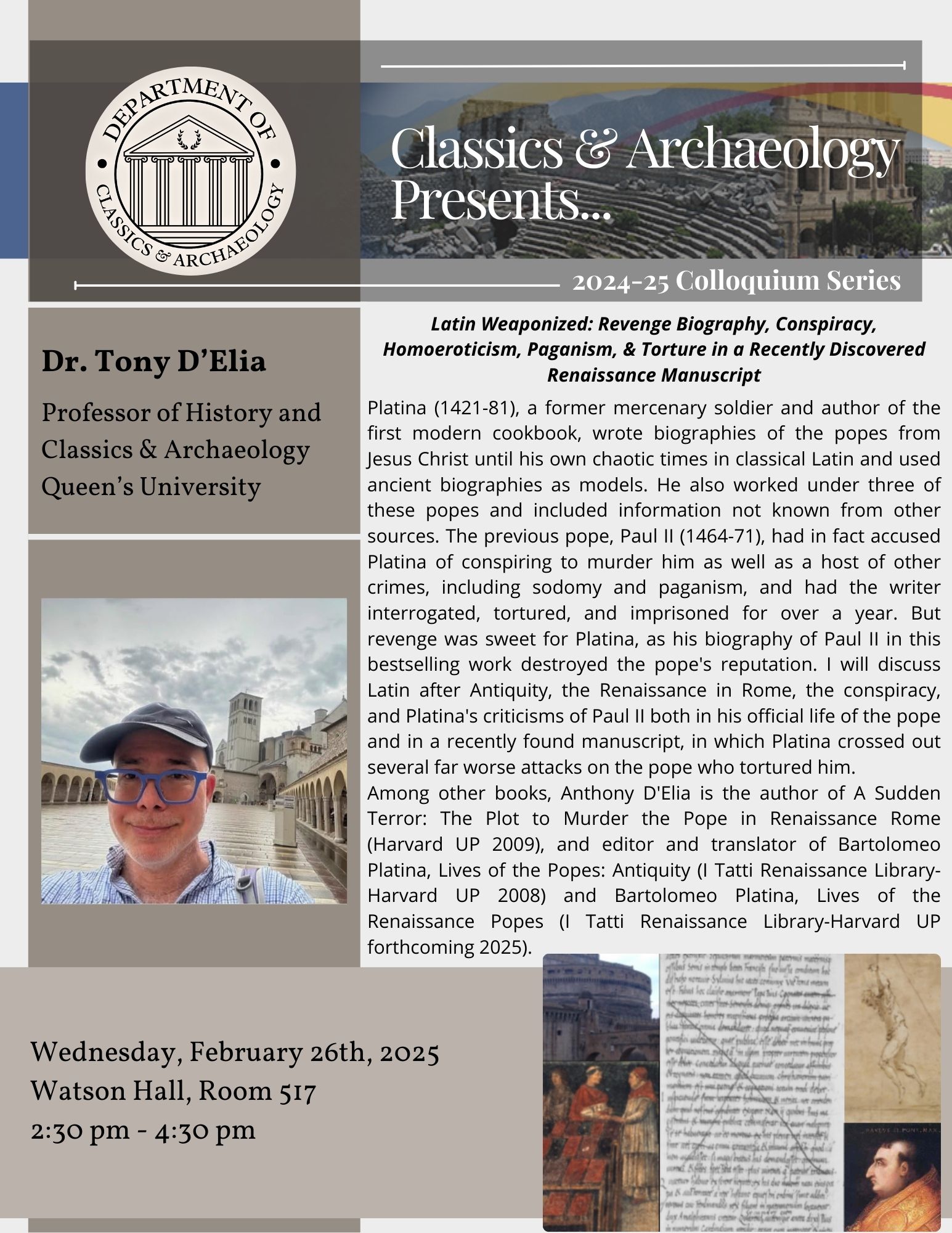
Dr. Anthony D'Elia
Wednesday, February 26th, 2025, from 2:30 PM - 4:30 PM in Watson Hall Room 517.
Latin Weaponized: Revenge Biography, Conspiracy, Homoeroticism, Paganism, & Torture in a Recently Discovered Renaissance Manuscript
Platina (1421-81), a former mercenary soldier and author of the first modern cookbook, wrote biographies of the popes from Jesus Christ until his own chaotic times in classical Latin and used ancient biographies as models. He also worked under three of these popes and included information not known from other sources. The previous pope, Paul II (1464-71), had in fact accused Platina of conspiring to murder him as well as a host of other crimes, including sodomy and paganism, and had the writer interrogated, tortured, and imprisoned for over a year. But revenge was sweet for Platina, as his biography of Paul II in this bestselling work destroyed the pope's reputation. I will discuss Latin after Antiquity, the Renaissance in Rome, the conspiracy, and Platina's criticisms of Paul II both in his official life of the pope and in a recently found manuscript, in which Platina crossed out several far worse attacks on the pope who tortured him. Among other books, Anthony D'Elia is the author of A Sudden Terror: The Plot to Murder the Pope in Renaissance Rome (Harvard UP 2009), and editor and translator of Bartolomeo Platina, Lives of the Popes: Antiquity (I Tatti Renaissance Library-Harvard UP 2008) and Bartolomeo Platina, Lives of the Renaissance Popes (I Tatti Renaissance Library-Harvard UP forthcoming 2025).
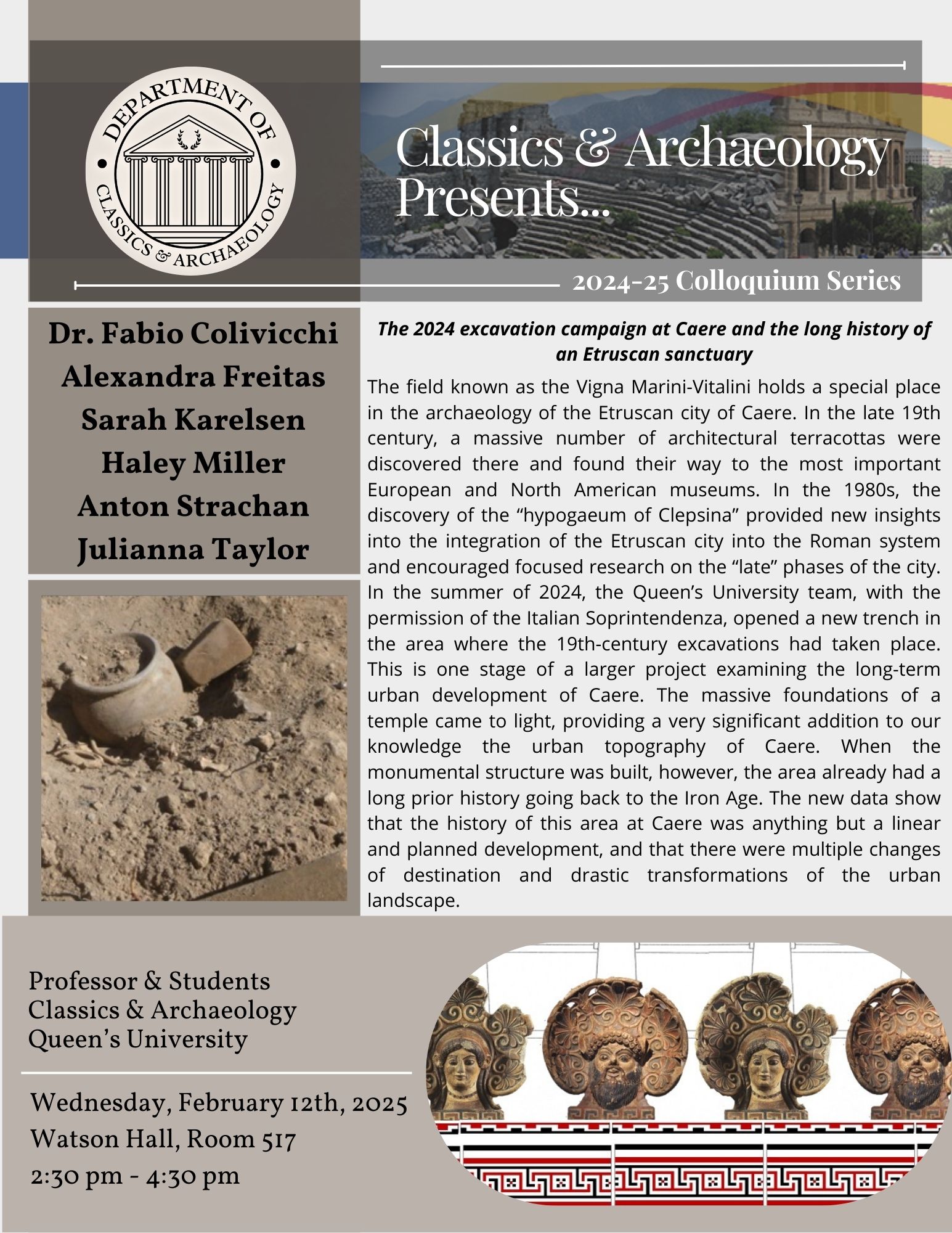
Dr. Colivicchi, Alexandra Freitas, Sarah Karelsen, Haley Miller, Anton Strachan, and Julianna Taylor
Professor & Students
Classics & Archaeology
Queen's University
Wednesday, February 12th, 2025, from 2:30PM - 4:30PM in Watson Hall Room 517.
The 2024 excavation campaign at Caere and the long history of an Etruscan sanctuary
The field known as the Vigna Marini-Vitalini holds a special place in the archaeology of the Etruscan city of Caere. In the late 19th
century, a massive number of architectural terracottas were discovered there and found their way to the most important European and North American museums. In the 1980s, the discovery of the “hypogaeum of Clepsina” provided new insights into the integration of the Etruscan city into the Roman system and encouraged focused research on the “late” phases of the city. In the summer of 2024, the Queen’s University team, with the permission of the Italian Soprintendenza, opened a new trench in the area where the 19th-century excavations had taken place. This is one stage of a larger project examining the long-term urban development of Caere. The massive foundations of a temple came to light, providing a very significant addition to our knowledge of the urban topography of Caere. When the monumental structure was built, however, the area already had a long prior history going back to the Iron Age. The new data show that the history of this area at Caere was anything but a linear and planned development and that there were multiple changes of destination and drastic transformations of the urban landscape.
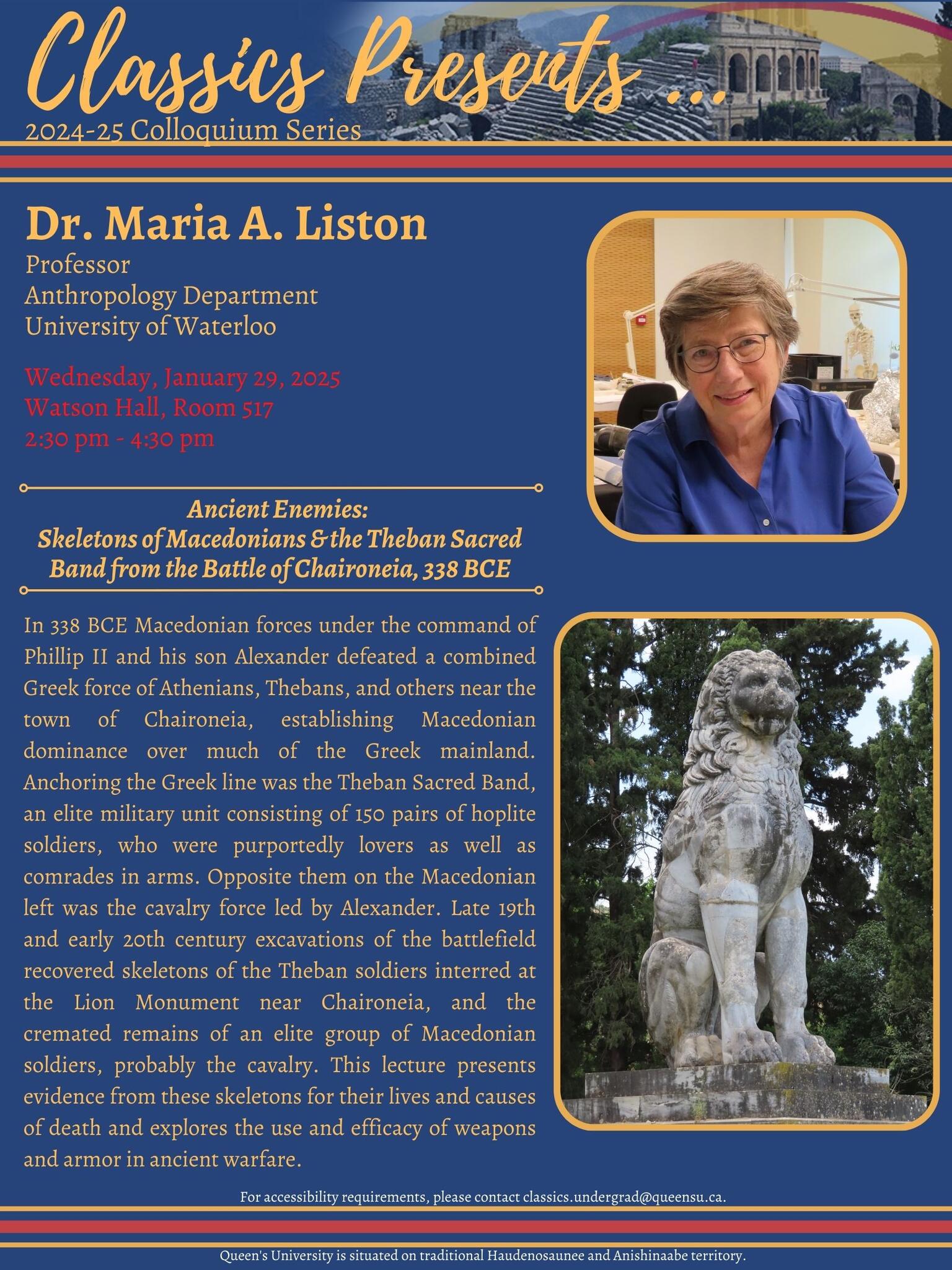
Dr. Maria A. Liston
Professor
Anthropology Department
University of Waterloo
Wednesday, January 29th, 2025, from 2:30 pm - 4:30 pm in Watson Hall Room 517.
Ancient Enemies: Skeletons of Macedonians and the Theban Sacred Band from the Battle of Chaironeia, 338 BCE
In 338 BCE Macedonian forces under the command of Phillip II and his son Alexander defeated a combined Greek force of Athenians, Thebans, and others near the town of Chaironeia, establishing Macedonian dominance over much of the Greek mainland. Anchoring the Greek line was the Theban Sacred Band, an elite military unit consisting of 150 pairs of hoplite soldiers, who were purportedly lovers as well as comrades in arms. Opposite them on the Macedonian left was the cavalry force led by Alexander. Late 19th and early 20th century excavations of the battlefield recovered skeletons of the Theban soldiers interred at the Lion Monument near Chaironeia, and the cremated remains of an elite group of Macedonian soldiers, probably the cavalry. This lecture presents evidence from these skeletons for their lives and causes of death and explores the use and efficacy of weapons and armour in ancient warfare.
Fall 2024
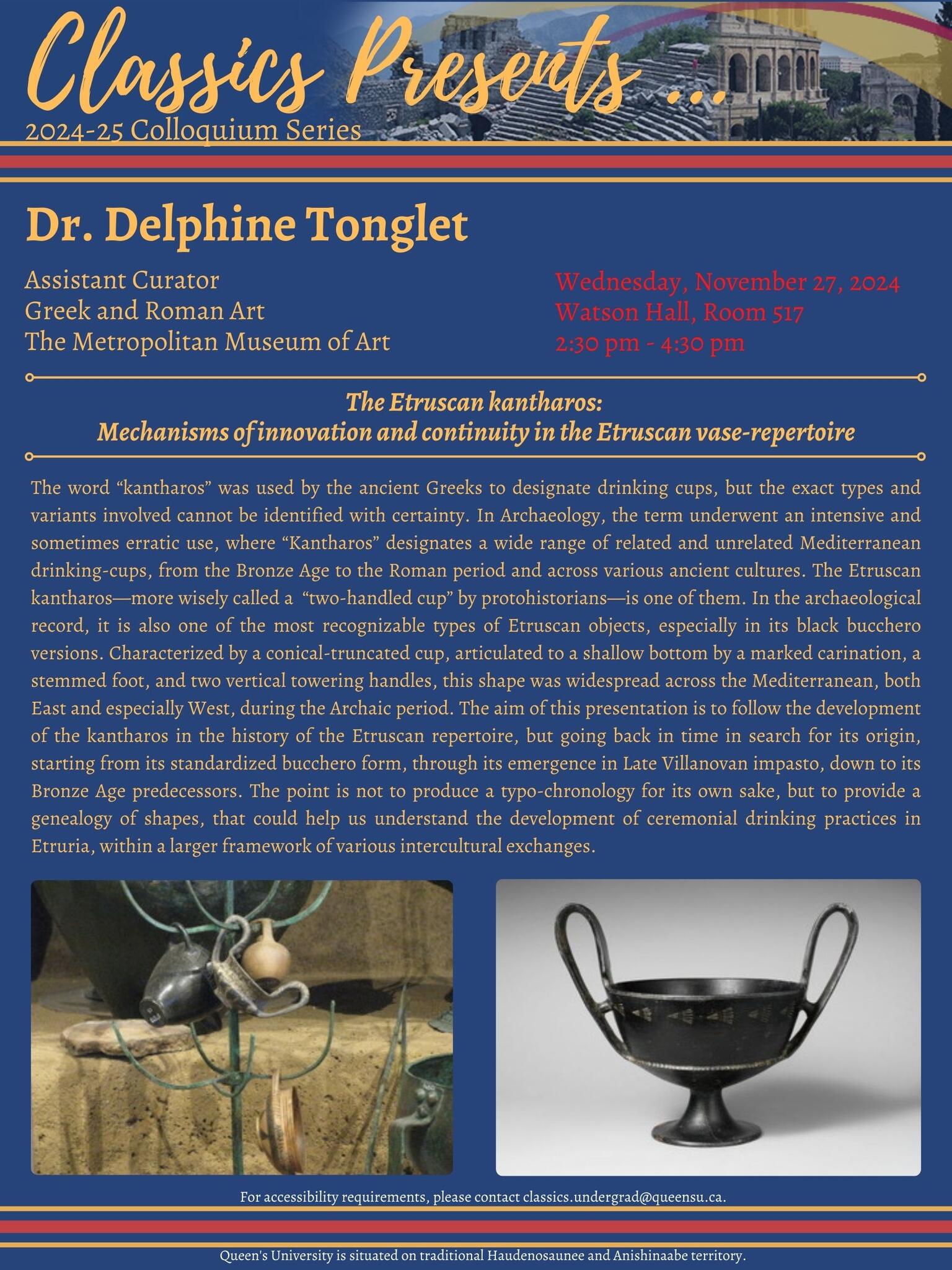
Dr. Delphine Tonglet
Assistant Curator
Greek and Roman Art
The Metropolitan Museum of Art
Wednesday, November 27th, 2024 at 2:30 PM in Watson Hall, Room 217.
The Etruscan Kantharos: Mechanisms of Innovation and Continuity in the Etruscan vase-repertoire
The word “kantharos” was used by the ancient Greeks to designate drinking cups, but the exact types and variants involved cannot be identified with certainty. In Archaeology, the term underwent an intensive and sometimes erratic use, where “Kantharos” designates a wide range of related and unrelated Mediterranean drinking-cups, from the Bronze Age to the Roman period and across various ancient cultures. The Etruscan kantharos—more wisely called a “two-handled cup” by protohistorians—is one of them. In the archaeological record, it is also one of the most recognizable types of Etruscan object, especially in its black bucchero versions. Characterized by a conical-truncated cup, articulated to a shallow bottom by a marked carination, a stemmed foot, and two vertical towering handles, this shape was widespread across the Mediterranean, both East and especially West, during the Archaic period. The aim of this presentation is to follow the development of the kantharos in the history of the Etruscan repertoire, but going back in time in search for its origin, starting from its standardized bucchero form, through its emergence in Late Villanovan impasto, down to its Bronze Age predecessors. The point is not to produce a typo-chronology for its own sake, but to provide a genealogy of shapes, that could help us understand the development of ceremonial drinking practices in Etruria, within a larger framework of various intercultural exchanges.
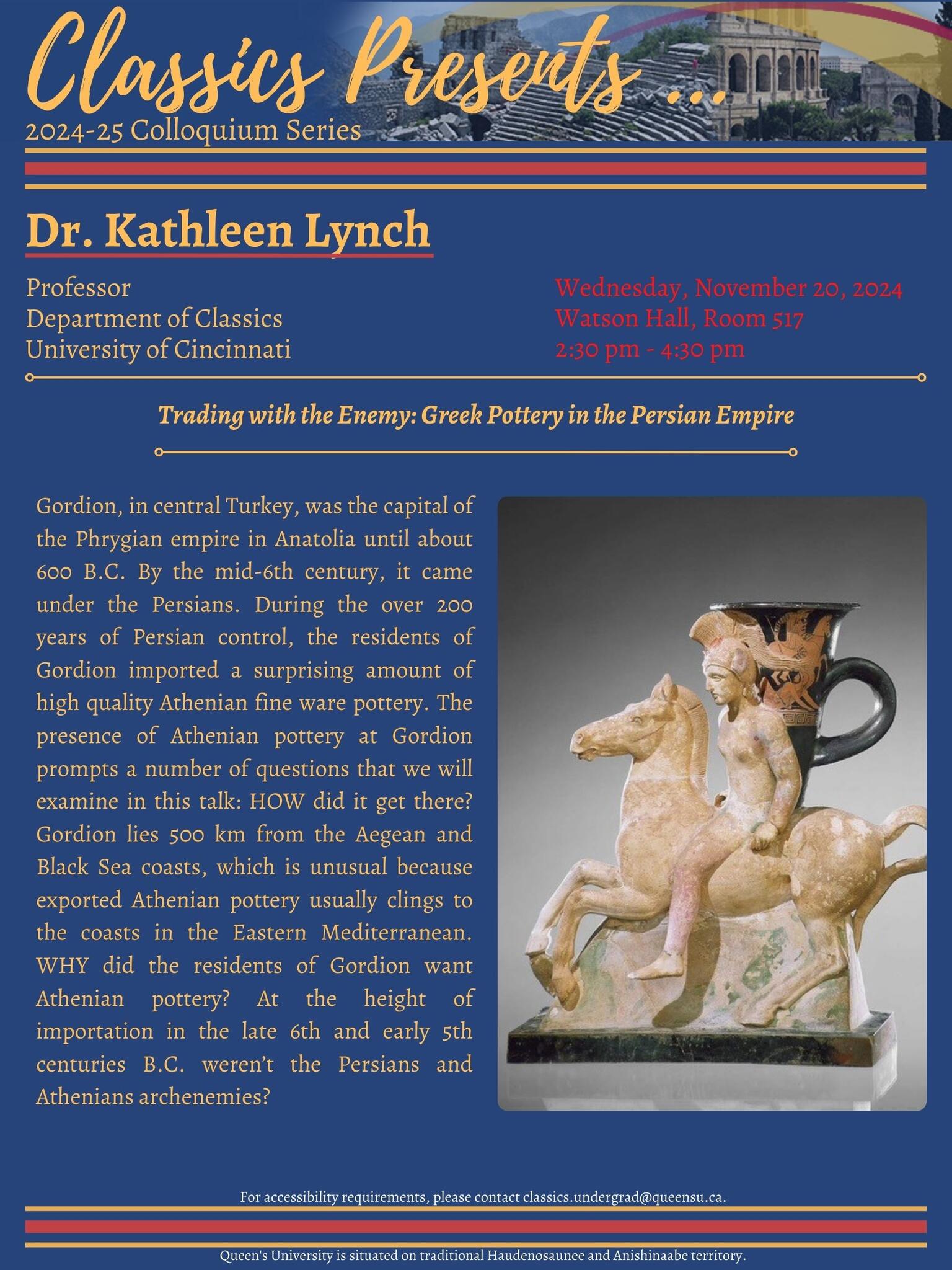
Dr. Kathleen Lynch
Department of Classics
University of Cincinnati
Wednesday, November 20th, 2024 from 2:30 pm, in Watson Hall Room 517.
Trading with the Enemy: Greek Pottery in the Persian Empire
Gordion, in central Turkey, was the capital of the Phrygian empire in Anatolia until about 600 B.C. By the mid-6th century, it came under the Persians. During the over 200 years of Persian control, the residents of Gordion imported a surprising amount of high-quality Athenian fine ware pottery. The presence of Athenian pottery at Gordion prompts a number of questions that we will examine in this talk: HOW did it get there? Gordion lies 500 km from the Aegean and Black Sea coasts, which is unusual because exported Athenian pottery usually clings to the coasts in the Eastern Mediterranean. WHY did the residents of Gordion want Athenian pottery? At the height of importation in the late 6th and early 5th centuries B.C. weren’t the Persians and Athenians archenemies?
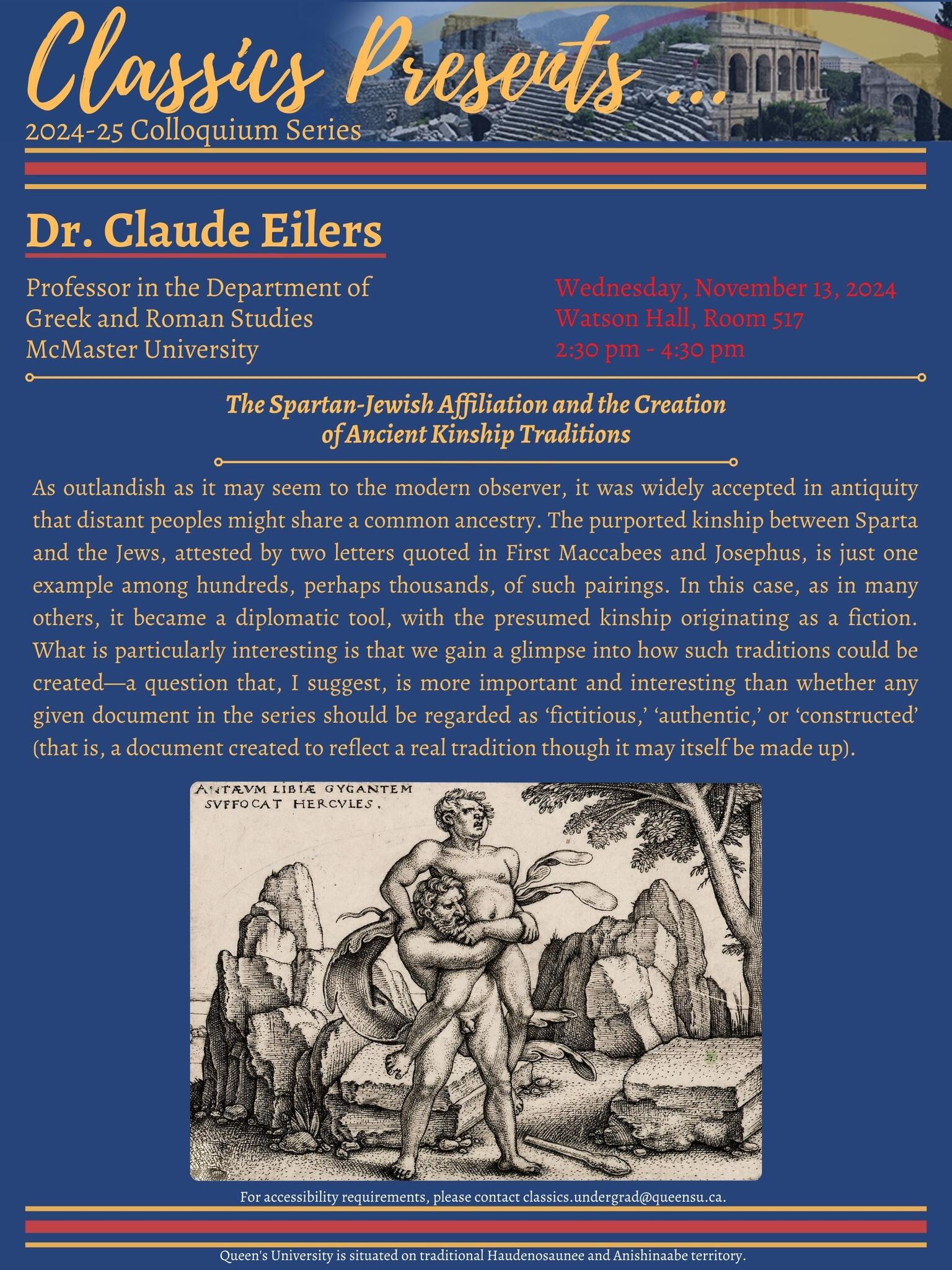
Dr. Claude Eilers
Professor
Department of Greek and Roman Studies at McMaster University
Monday, November 13th, 2024 at 2:30 pm, in Watson Hall, Room 517.
The Spartan-Jewish Affiliation and the Creation of Ancient Kinship Traditions
As outlandish as it may seem to the modern observer, it was widely accepted in antiquity that distant peoples might share a common ancestry. The purported kinship between Sparta and the Jews, attested by two letters quoted in First Maccabees and Josephus, is just one example among hundreds, perhaps thousands, of such pairings. In this case, as in many others, it became a diplomatic tool, with the presumed kinship originating as a fiction. What is particularly interesting is that we gain a glimpse into how such traditions could be created—a question that, I suggest, is more important and interesting than whether any given document in the series should be regarded as ‘fictitious,’ ‘authentic,’ or ‘constructed’ (that is, a document created to reflect a real tradition though it may itself be made up).

PhD candidate Julien Dechevez
University of Liege
Wednesday, October 9th, at 2:30 pm, in Watson Hall, Room 517
The Sale of Priesthoods in Greek Cities: Procedures, Mechanisms and Implications
In ancient Greece, there were four different ways to acquire a priesthood, which varied according to the customs of each city: by inheritance, by election, by lot, and by purchase. While the practice of selling a priesthood through public auction remains unknown in mainland Greece, it became widespread in the Aegean islands and Anatolia between the 4th century BC and the 2nd century AD. This process is well-documented through contracts that were drawn up on the occasion of these sales, some of which have been preserved on stone. This paper aims to explore the procedures and mechanisms behind the sale of priesthoods and its broader implications for the social, economic, and religious life of ancient Greek communities. Εxamining these detailed documents, which provide extensive information about the terms of holding a religious office such as age, gender, perquisites, and ritual duties allows us to investigate the practical aspects of assuming a priesthood in the ancient Greek world.
Dr. Michael Sampson
Department of Classics
University of Manitoba
Monday, September 23rd, 2024 from 4:00 - 6:00 pm, in Watson Hall Room 517
A Sapphic Scandal and Scholarly Ethics
When Dirk Obbink announced in January 2014 that he had discovered two new poems by Sappho on a recently surfaced papyrus fragment, the news caused a media frenzy and an outburst of scholarship on the new texts. In the decade since the announcement, however, scholarly scrutiny of the papyrus itself – as an archaeological object – has exposed the published accounts of its origins as bogus. Amazingly, the publisher Brill even retracted formally one of Obbink’s publications on the topic – a virtually unheard of event in the world of Classical scholarship. In this paper, I present the history of the discovery and the forensic exposure of the papyrus’ illicit origins before turning to the larger issues of research ethics in Classical scholarship and the importance of provenance research for the field in general – outside of exclusively archaeological circles.
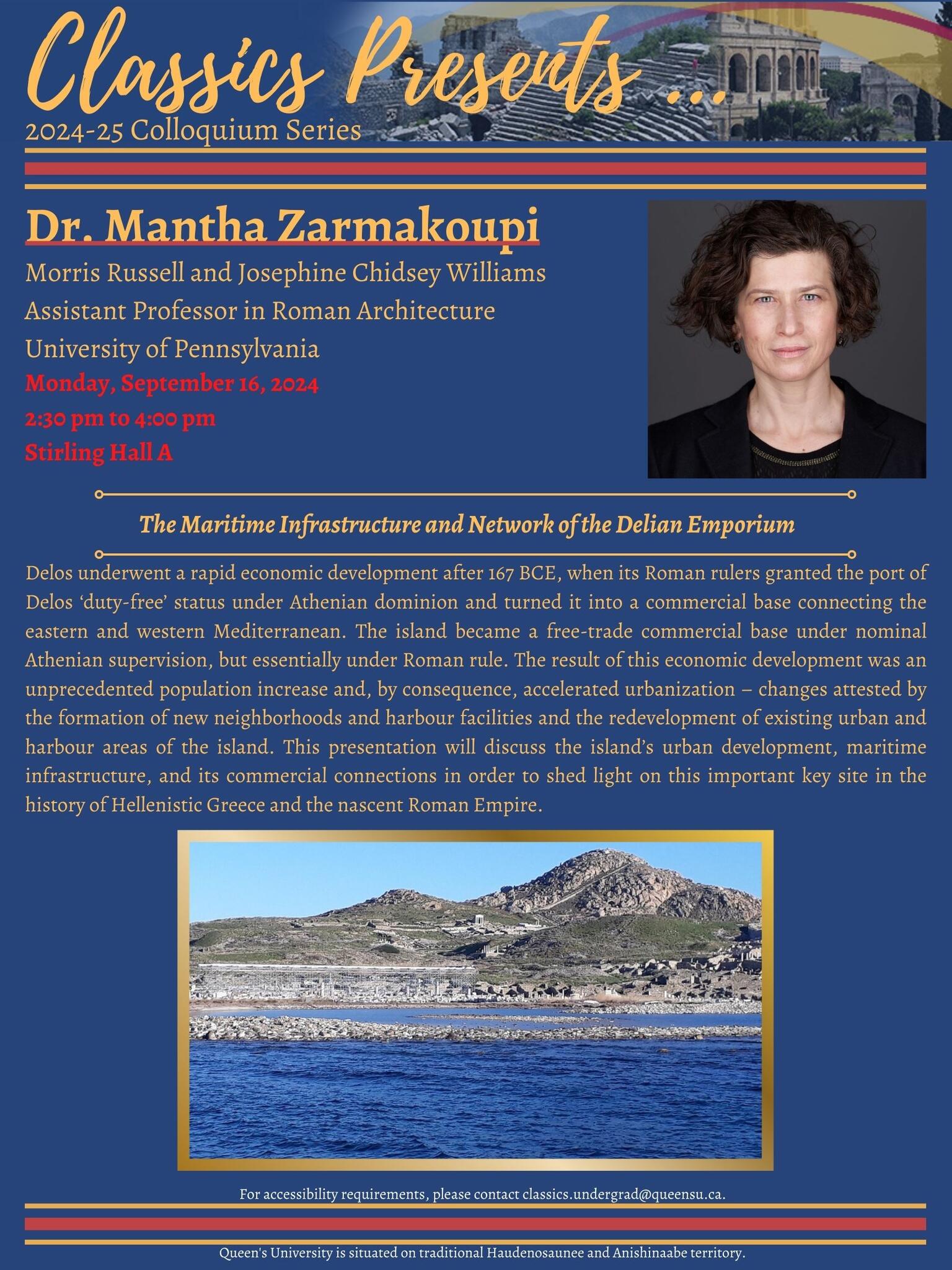
Dr. Mantha Zarmakoupi
Morris Russell and Josephine Chidsey Williams
Assistant Professor in Roman Architecture
University of Pennsylvania
Monday, September 16th, 2024 from 2:30 - 4:00 pm, in Stirling Hall Room A
The Maritime Infrastructure and Network of the Delian Emporium
Delos underwent a rapid economic development after 167 BCE, when its Roman rulers granted the port of Delos ‘duty-free’ status under Athenian dominion and turned it into a commercial base connecting the eastern and western Mediterranean. The island became a free-trade commercial base under nominal Athenian supervision, but essentially under Roman rule. The result of this economic development was an unprecedented population increase and, by consequence, accelerated urbanization – changes attested by the formation of new neighborhoods and harbour facilities and the redevelopment of existing urban and harbour areas of the island. This presentation will discuss the island’s urban development, maritime infrastructure, and its commercial connections in order to shed light on this important key site in the history of Hellenistic Greece and the nascent Roman Empire.
Winter 2024
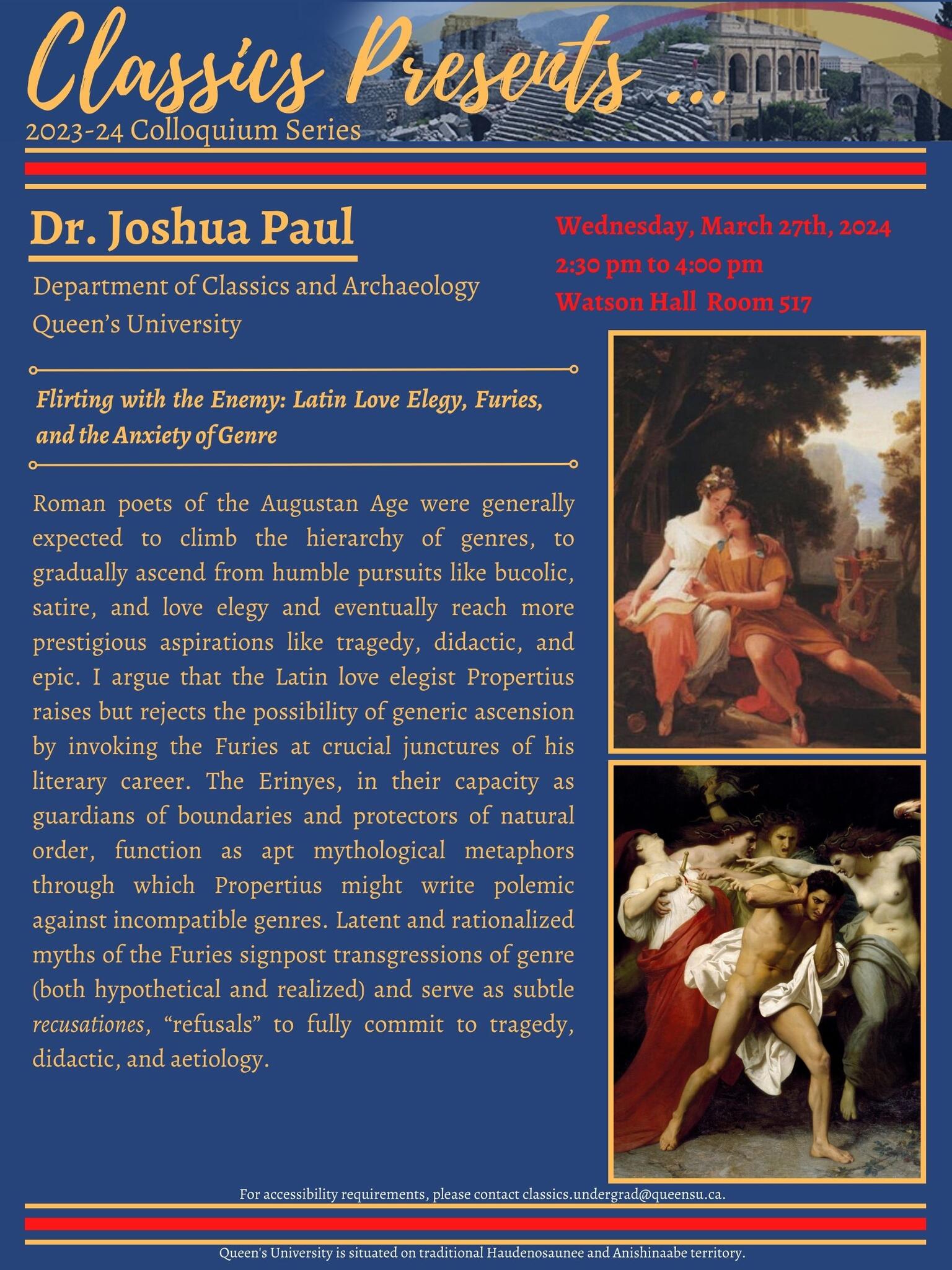
Dr. Joshua Paul
Wednesday, March 27th, 2024 from 2:30 - 4:00 pm, in Watson Hall Room 517
Flirting with the Enemy: Latin Love Elegy, Furies, and the Anxiety of Genre
Roman poets of the Augustan Age were generally expected to climb the hierarchy of genres, to gradually ascend from humble pursuits like bucolic, satire, and love elegy and eventually reach more prestigious aspirations like tragedy, didactic, and epic. I argue that the Latin love elegist Propertius raises but rejects the possibility of generic ascension by invoking the Furies at crucial junctures of his literary career. The Erinyes, in their capacity as guardians of boundaries and protectors of natural order, function as apt mythological metaphors through which Propertius might write polemic against incompatible genres. Latent and rationalized myths of the Furies signpost transgressions of genre (both hypothetical and realized) and serve as subtle recusationes, “refusals” to fully commit to tragedy, didactic, and aetiology.
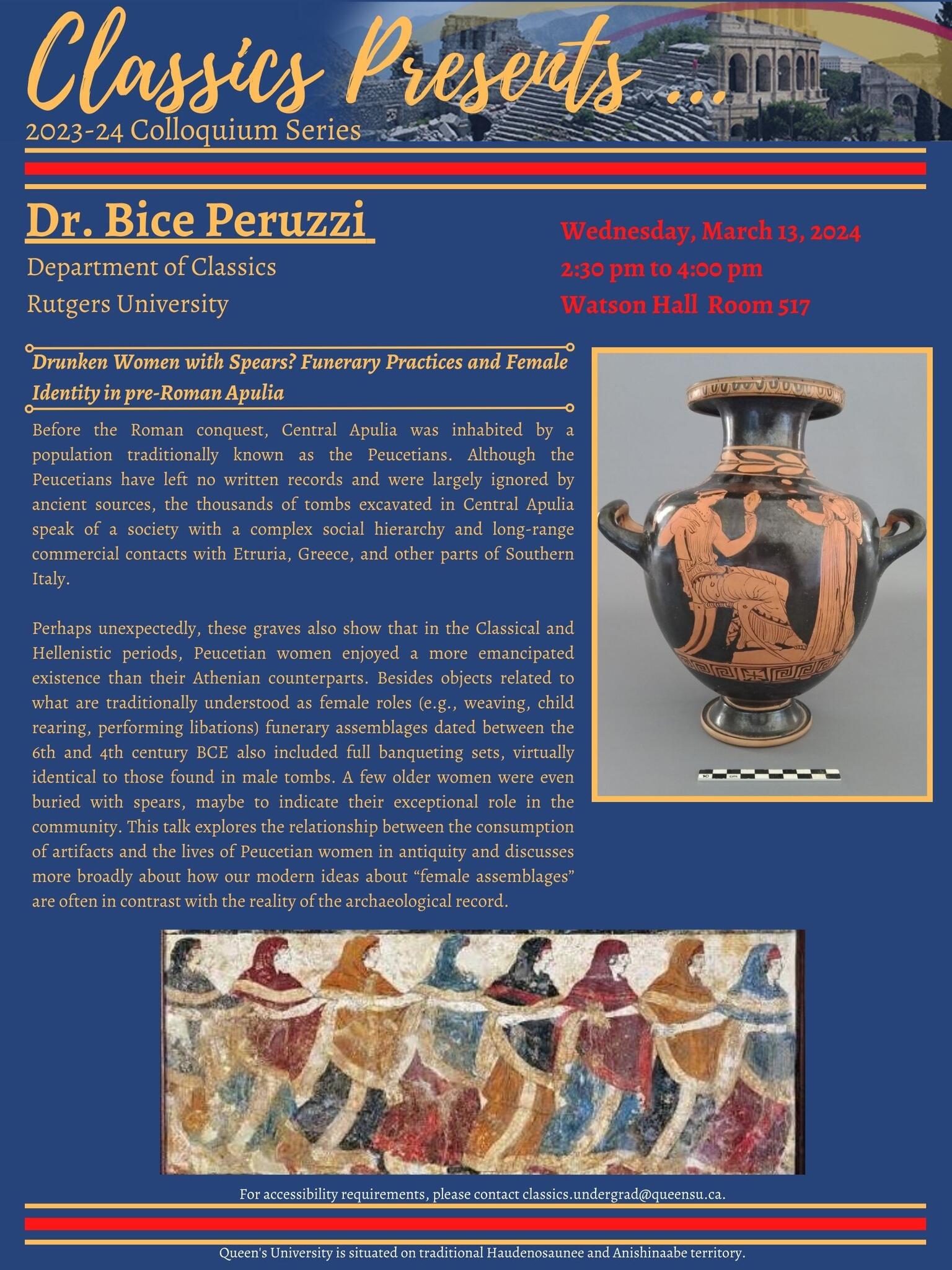
Dr. Bice Peruzzi
Wednesday, March 13th, 2024 from 2:30 - 4:00 pm, in Watson Hall Room 517
Drunken Women with Spears? Funerary Practices and Female Identity in pre-Roman Apulia
Before the Roman conquest, Central Apulia was inhabited by a population traditionally known as the Peucetians. Although the Peucetians have left no written records and were largely ignored by ancient sources, the thousands of tombs excavated in Central Apulia speak of a society with a complex social hierarchy and long-range commercial contacts with Etruria, Greece, and other parts of Southern Italy.
Perhaps unexpectedly, these graves also show that in the Classical and Hellenistic periods, Peucetian women enjoyed a more emancipated existence than their Athenian counterparts. Besides objects related to what are traditionally understood as female roles (e.g., weaving, child rearing, performing libations) funerary assemblages dated between the 6th and 4th century BCE also included full banqueting sets, virtually identical to those found in male tombs. A few older women were even buried with spears, maybe to indicate their exceptional role in the community. This talk explores the relationship between the consumption of artifacts and the lives of Peucetian women in antiquity and discusses more broadly about how our modern ideas about “female assemblages” are often in contrast with the reality of the archaeological record.
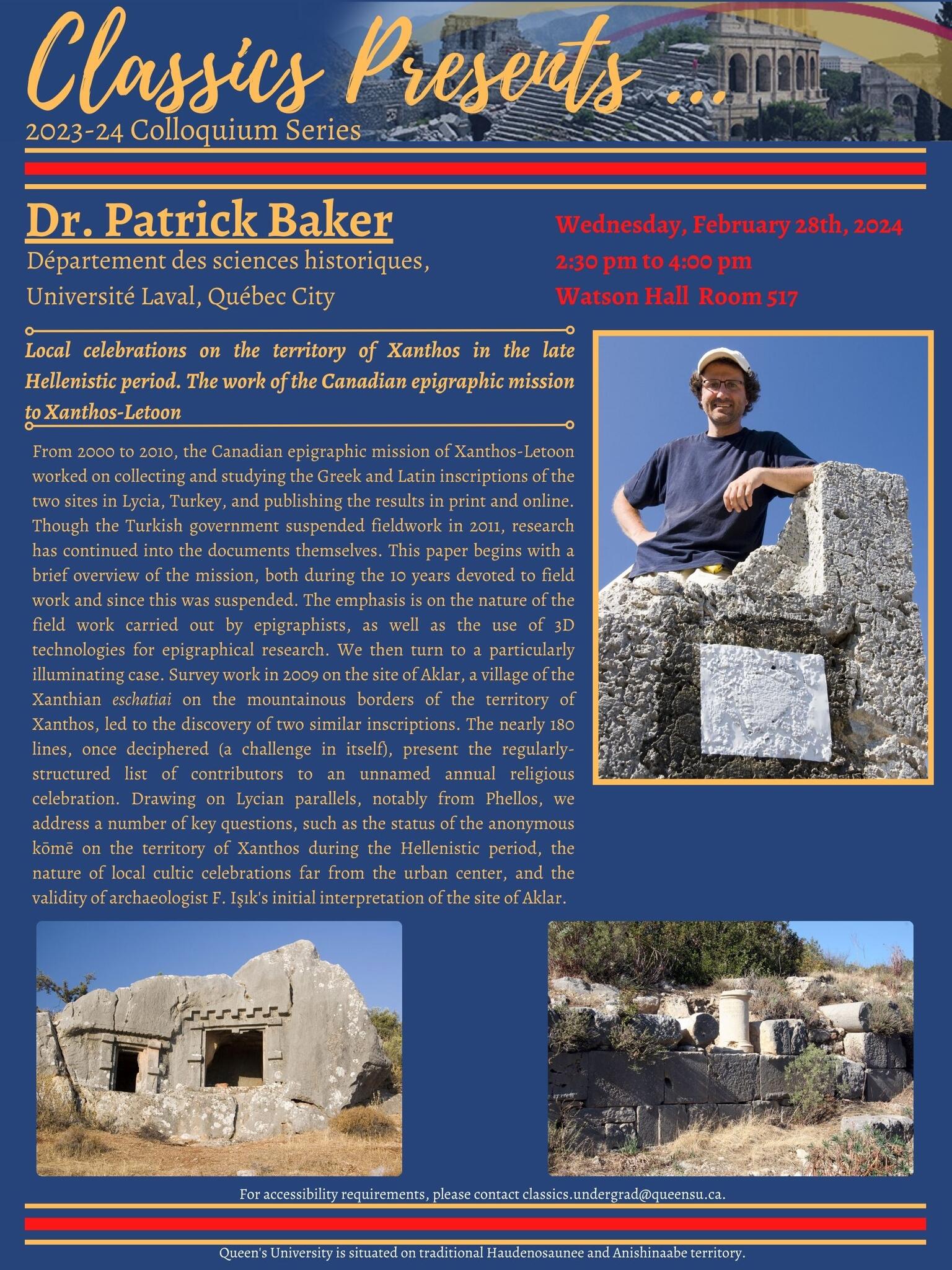
Dr. Patrick Baker
Wednesday, February 28, 2024, from 2:30 pm - 4:00 pm in Watson Hall Room 517
Local celebrations on the territory of Xanthos in the late Hellenistic period. The work of the Canadian epigraphic mission to Xanthos-Letoon
From 2000 to 2010, the Canadian epigraphic mission of Xanthos-Letoon worked on collecting and studying the Greek and Latin inscriptions of the two sites in Lycia, Turkey, and publishing the results in print and online. Though the Turkish government suspended fieldwork in 2011, research has continued into the documents themselves. This paper begins with a brief overview of the mission, both during the 10 years devoted to fieldwork and since this was suspended. The emphasis is on the nature of the fieldwork carried out by epigraphists, as well as the use of 3D technologies for epigraphical research. We then turn to a particularly illuminating case. Survey work in 2009 on the site of Aklar, a village of the Xanthian eschatiai on the mountainous borders of the territory of Xanthos, led to the discovery of two similar inscriptions. The nearly 180 lines, once deciphered (a challenge in itself), present the regularly-structured list of contributors to an unnamed annual religious celebration. Drawing on Lycian parallels, notably from Phellos, we address a number of key questions, such as the status of the anonymous kōmē on the territory of Xanthos during the Hellenistic period, the nature of local cultic celebrations far from the urban center, and the validity of archaeologist F. Işık's initial interpretation of the site of Aklar.
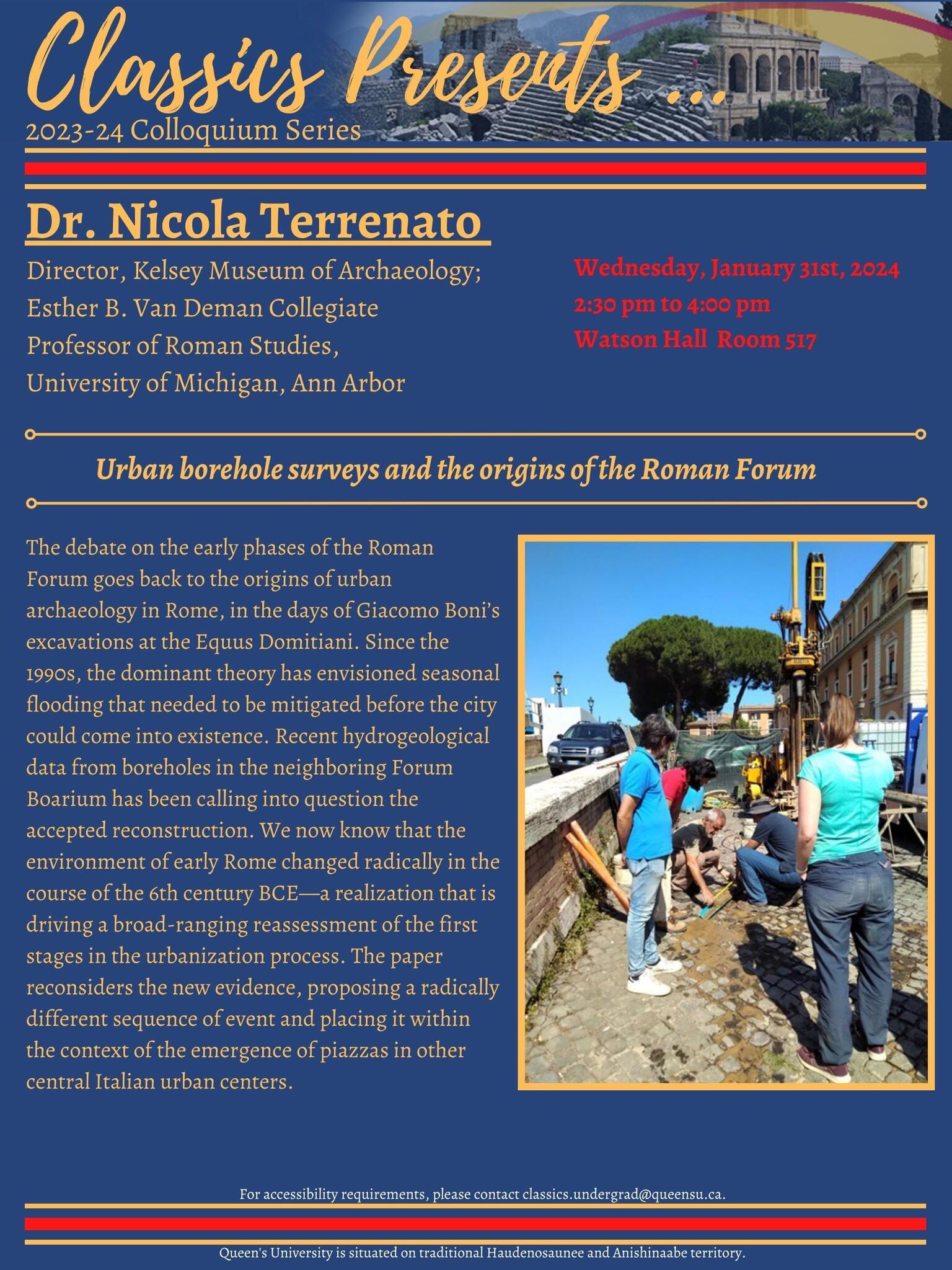
Dr. Nicola Terrenato
Wednesday, January 31st, 2024, from 2:30 pm - 4:00 pm in Watson Hall Room 517
Urban borehole surveys and the Origins of the Roman Forum
The debate on the early phases of the Roman Forum goes back to the origins of urban archaeology in Rome, in the days of Giacomo Boni’s excavations at the Equus Domitiani. Since the 1990s, the dominant theory has envisioned seasonal flooding that needed to be mitigated before the city could come into existence. Recent hydrogeological data from boreholes in the neighboring Forum Boarium has been calling into question the accepted reconstruction. We now know that the environment of early Rome changed radically in the course of the 6th century BCE—a realization that is driving a broad-ranging reassessment of the first stages in the urbanization process. The paper reconsiders the new evidence, proposing a radically different sequence of events and placing it within the context of the emergence of piazzas in other central Italian urban centers.
Fall 2023
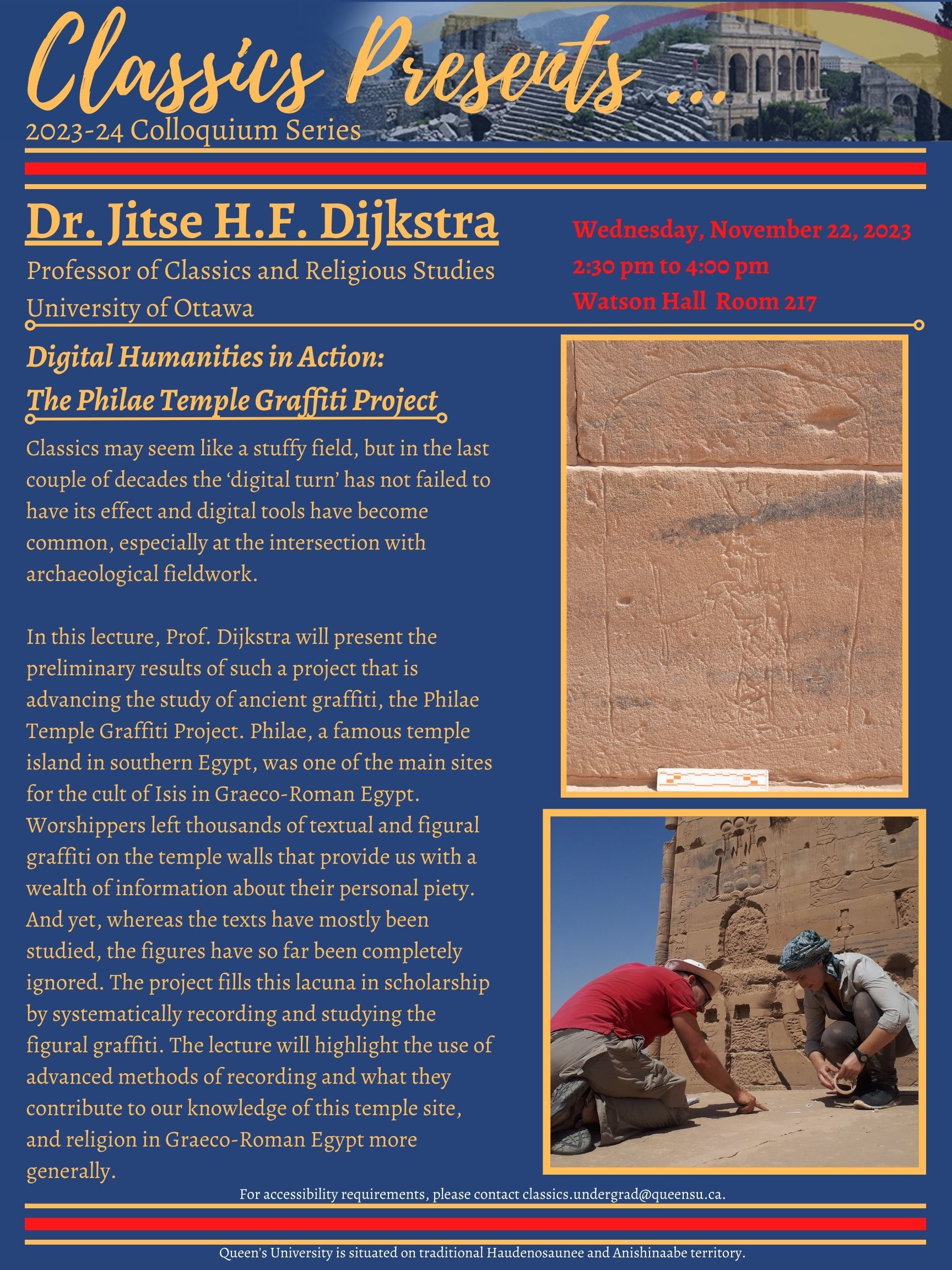
Dr. Jitse H.F. Dijkstra
Wednesday, November 22, 2023, from 2:30 pm - 4:00 pm in Watson Hall Room 217
Digital Humanities in Action: The Philae Temple Graffiti Project
Classics may seem like a stuffy field, but in the last couple of decades the ‘digital turn’ has not failed to have its effect and digital tools have become common, especially at the intersection with archaeological fieldwork. In this lecture, Prof. Dijkstra will present the preliminary results of such a project that is advancing the study of ancient graffiti, the Philae Temple Graffiti Project. Philae, a famous temple island in southern Egypt, was one of the main sites for the cult of Isis in Graeco-Roman Egypt. Worshippers left thousands of textual and figural graffiti on the temple walls that provide us with a wealth of information about their personal piety. And yet, whereas the texts have mostly been studied, the figures have so far been completely ignored. The project fills this lacuna in scholarship by systematically recording and studying the figural graffiti. The lecture will highlight the use of advanced methods of recording and what they contribute to our knowledge of this temple site, and religion in Graeco-Roman Egypt more generally.
